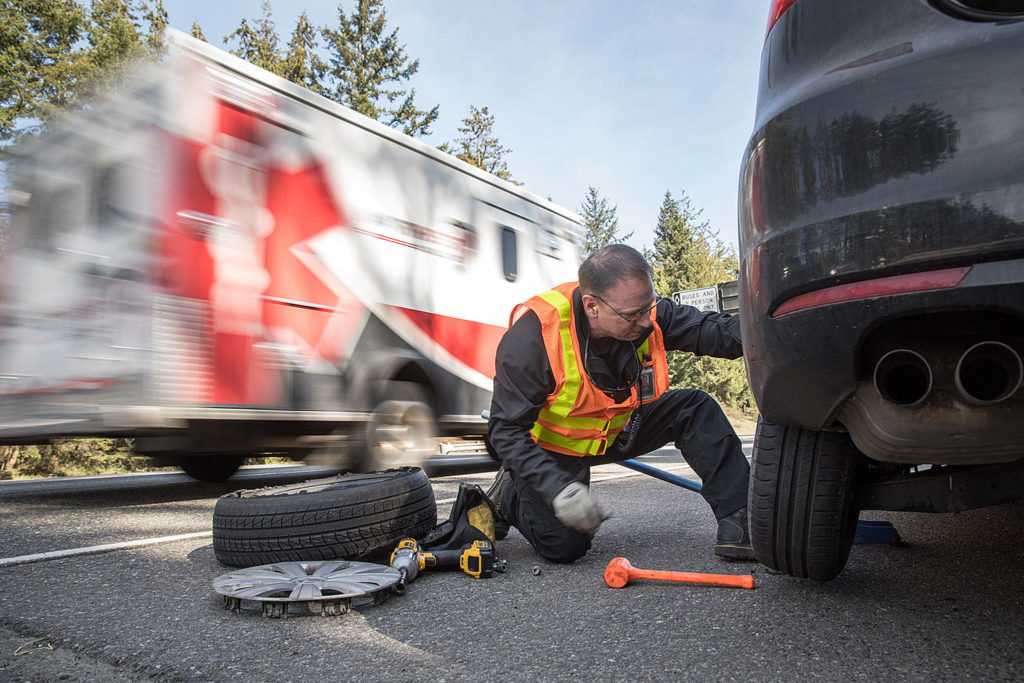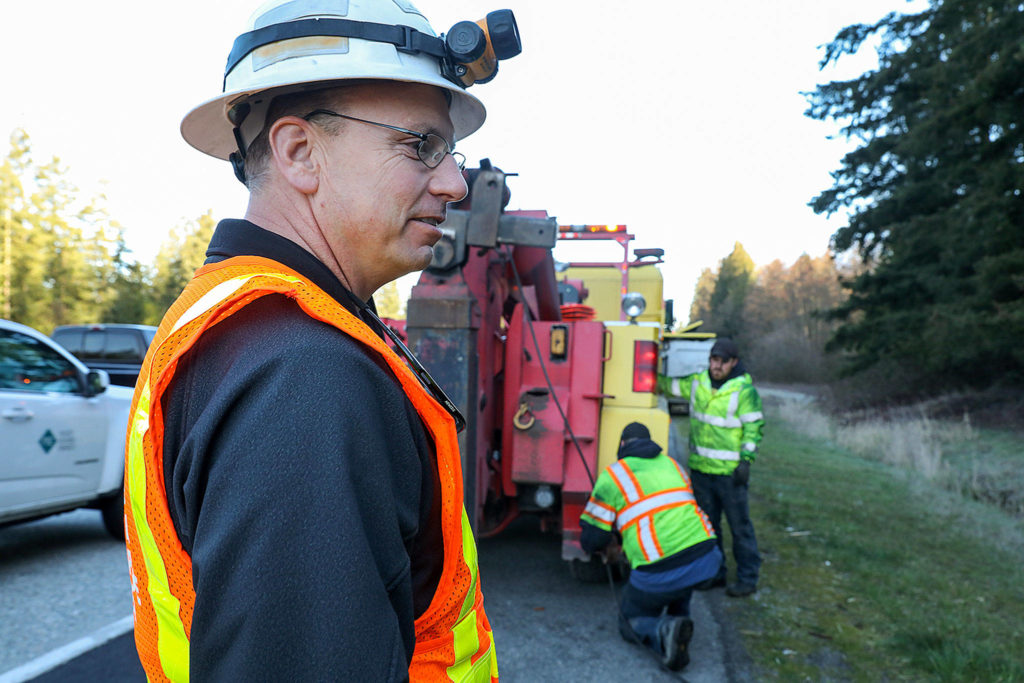Being in a broken down car is stressful.
I drove clunkers for over a decade and it was a victory every time their engines started and they reached my destination without incident. But there were plenty of times the engine light would blaze from the dashboard, or the steering suddenly got wobbly from a flat, or some horrific noise squealed from under the hood.
Then I’d have to pull off to the shoulder and hope I could remedy whatever plagued my car until a pro could fix it.
Years ago while driving north on I-5 past Marysville I felt the shake and knew a flat was at fault. I thought maybe the tire pressure was just a little low and I could revive it with a pump kit my parents gave me. But it was no use.
No matter. I knew what to do because my father made me replace the tire when I was a teenage driver at an inhumane weekend early morning hour, like he was some kind of parenting drill sergeant. (Don’t tell him, but in hindsight, it was wise of him.) I opened the hood and grabbed the spare. From the wagon’s rear gate, I lifted the mat and found the jack. But the tire iron was gone.
Shame on me.
I was ready to call for roadside assistance or tow service (but I was significantly less ready to pay for it as a broke, young journalist), but within minutes a Washington State Department of Transportation truck pulled up behind me. The man driving the truck was part of the Incident Response Team, a state-funded roadside assistance crew around since the 1960s that helps keeps roads clear of breakdowns, collisions and debris.
He asked what happened, took a quick look at my almost-there tire replacement work, grabbed a tire iron and replaced the flat with the spare. With a glance at the spare donut, he gave a final warning to be careful how far I drove on it and to replace it as soon as possible with a real tire.
Then he was on his way, and I looped back to Lake Stevens.
Over the decades the state’s Incident Response Team across the state similarly has helped tens of thousands of people. The six-person Snohomish County unit responds to about 8,000 incidents on average each year, WSDOT Incident Response Team lead tech Ken Buretta said.
“We respond to a lot of calls,” he said.
That includes Lee Gresko and Marv Kvamme of Mountlake Terrace whose truck recently had a flat on I-5 near Everett. They called roadside assistance but while waiting an Incident Response Team employee arrived, saw Kvamme struggle with the spare tire and stepped in to help.
“He took charge!” Gresko wrote. “We felt safe and fortunate. He refused money or flowers as thanks! I didn’t ask his name.”
Gresko was so impressed with the shoulder savior she emailed The Herald with their experience as a story idea, which we sent on to the program’s managers.
“I think of WSDOT as ‘road angels’ from my three experiences,” she wrote. “They seem to just appear!”
Buretta was the one who helped Gresko and Kvamme. His response to their glowing praise was simple.
“This was me who helped the elderly couple,” he said. “Glad to (have) been of service.”
It’s not often they receive kudos after they’ve sent drivers on their way. Buretta estimated the Incident Response Team gets official comments on about 20% of the incidents his crew and he respond to.
Two previous Street Smarts columnist wrote about the program and its employees, including Buretta in 2018 and again in 2019. But it’s worth highlighting these workers because their labor, along with others along the side of busy freeways and highways, is often dangerous.
Over the decade Buretta has been with the Incident Response Team, vehicles’ safety features have expanded with drift warnings, lane assist and more. But he can’t say drivers are any better at avoiding collisions.
“Oh my gosh, no,” he said. “It’s sad to say that.”
During the pandemic in 2020, there were about 6,000 incidents. With less traffic, Buretta said the severity of crashes his team responded to has risen.
“The drivers we still have on the road with no people in front of them are driving at erratic speeds,” he said.
The WSDOT reported an average of almost 726 highway work zone injuries each year. Most of the injuries or deaths are drivers and passengers.
In 2019, there were 10 fatal, 23 serious injury, and 475 minor injury crashes in work zones. That’s on top of 1,672 collisions that only damaged property and the total number is a decline from a decade peak in 2010.
Former Street Smarts columnist Melissa Slager wrote in 2018 about the close call Buretta had that resulted in a concussion. His Snohomish County-based colleague Trent Galusha suffered a similar injury from a careless driver throwing a drink out of the passing vehicle’s window that hit the state employee in the head. It caused a traumatic brain injury that required months of treatment.
Along with safety, getting roads clear and traffic moving is an economic boon that saves over $65 million per year in lost time and fuel, according to WSDOT estimates.
Buretta credits the people he works with for putting themselves at risk to get traffic flowing. His team includes: Galusha, Mark Dunkin, Dave Jensen, Alvin Leorna and Bryan Locken, as well as call-out drivers Theresa Wood and Peter Groth.
What to do
Turn on your headlights, especially when it’s raining.
Call 911 if debris is in the roadway, your vehicle becomes disabled or you are in a collision.
If possible, get to the shoulder. The safest place to wait is in your car with your safety belt secured.
Move over. Give Incident Response Team members, tow trucks, emergency medical service, firefighters and law enforcement plenty of room. When driving by, change over a lane if possible, and slow down when passing crews.
Provide feedback about Incident Response Team help in an online survey at https://bit.ly/3a88grJ.
Have a question? Call 425-339-3037 or email streetsmarts@heraldnet.com. Please include your first and last name and city of residence.
Talk to us
> Give us your news tips.
> Send us a letter to the editor.
> More Herald contact information.



























